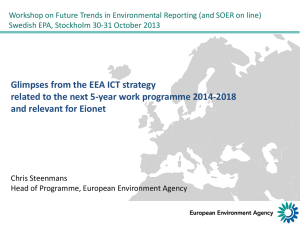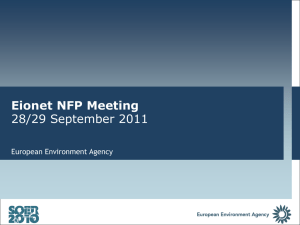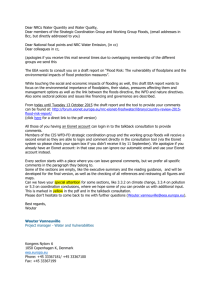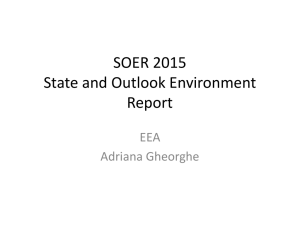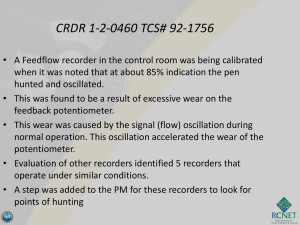Short info on the SOER2015 process
advertisement
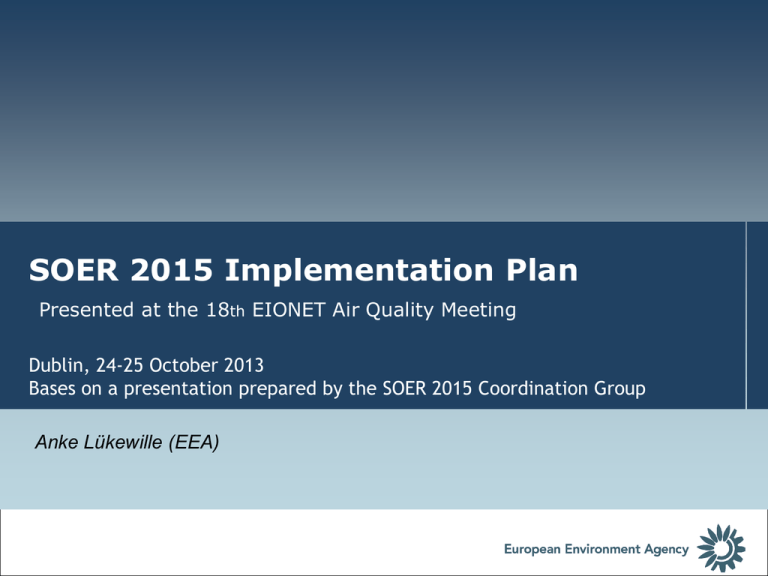
SOER 2015 Implementation Plan Presented at the 18th EIONET Air Quality Meeting Dublin, 24-25 October 2013 Bases on a presentation prepared by the SOER 2015 Coordination Group Anke Lükewille (EEA) SOER […] publish a report on the state of, trends in and prospects for the environment every five years 1995 1996 1997 1998 1999 2000 2001 2002 2003 2004 2005 2006 2007 2008 2009 2010 2011 2012 2013 ... - report (151 pp) + summary SOER 1995 - addresses 5 EAP targets - focus on sectoral integration - big report (446 pp) + summary SOER 1999 - addresses environmental trends - focus on DPSIR, link between issues - bigger report (569 pp, Part A, B & C) SOER 2005 - addresses air, water, land - focus on DPSIR, core set of indicators - several reports (Parts A, B, C + Synthesis) SOER 2010 - addresses 6EAP priority areas - focus on systemic challenges SOER 2015 More of the same, or something different? ... Both! What should stay similar? What might be different? • Maintain familiar structure, Parts A (global), B (Europe), Part C (national), Synthesis • Build more on other EEA work, more focus on, and refering to, existing indicators and reports • Expand on existing ‘narrative‘, i.e. analysis of systemic challenges, see SOER 2010 • Involve stakeholders more, especially in reflecting on implications and ‘prospects‘ Aim Publish a credible and reliable, relevant and timely, legitimate and transparent, targeted and accessible assessment in 2015. SOER 2015 A suite of product(s): short briefs + up-to-date indicators Social TechnoLogical Economic Environmental Political DATA-related DATA-related SOER 2015 Synthesis • Focus: A synthesis across different SOER 2015 parts to provide a strategic integrated and cross-thematic assessment • Format: 200 pages report, A5 format (mulitple languages); in addition we will explore scope for more interactive, derivative publications • Basis: Key conclusions from the other SOER 2015 parts; reflections based on flanking activities; and dedicated stakeholder workshops • Eionet: Formal Eionet consultation (May/June 2014); dedicated EEA Management Board seminar in March 2014 SOER 2015 Part A – Global Megatrends • Focus: An updated assessment of global megatrends (GMT), i.e. focussing on the same issues presented in SOER 2010 GMT fiches FLIS indicators • Format: 11 GMT fiches, 4 pages each; complemented by showing indicators used in GMT fiches within SOER 2015 Online • Basis: 8 non-environmental GMT primarly based on non-EEA sources, 3 environmental GMT building also on thematic EEA information • Eionet: Eionet consultation on GMT fiches (May/June 2014); discussion with NRC-FLIS network on underpinning analysis SOER 2015 Part B – Thematic SOE information ! • Focus: A series of brief summaries of state and trend in key environmental themes, guide through EEA knowledge base thematic fiches EEA indicators • Format: 20-30 thematic fiches, 4 pages; complemented by an online presentation to integrate fiches with EEA thematic indicators • Basis: Part B will primarily build on and guide to regular EEA reporting, indicators and assessment work within the respective thematic areas • Eionet: Eionet feedback on structure and topics (Oct 2013); Eionet consultation on fiches (Mar/Apr 2014); regular data flows SOER 2015 Part C – Country level SOE information (1) ! • Focus: A series of summaries of national state of environment assessments, to show key environmental issues at country level country fiches • Format: One country fiche per country, 4 pages each (based on a template and guidance by EEA to ensure some level of comparability) • Basis: Drafted by countries; country fiches should largely be based on – or provide summaries of – existing national SOE reports • Eionet: Eionet gives feedback on template and guidance (Oct 2013), based on this NFP and/or NRC-SOE draft country fiches and update SERIS (estimated average workload: 10 to 15 days per country) SOER 2015 Part C – Cross-country comparisons (2) ! • Focus: A series of indicator-based country comparisons for 8-10 selected themes based on existing EEA indicators omparison fiches EEA & country indicators • Format: 8 to 10 cross-country comparison fiches, 4 pages each; each based on one established EEA indicator; in SOER 2015 online scope to link this national intepretation of same indicator via SENSE • Basis: Drafted by EEA; cross-country comparisons based on EEA (CSI) indicators with country information; supplemented by SENSE • Eionet: Eionet feedback on indicator selection and method (Oct 2013); Eionet consultation on cross-country comparison fiches (Mar/Apr 2014); plus (voluntary) contributions to SENSE SOER 2015 SOER 2015 Online = NOT the same as SOE Online • Focus: An internet based representation of all SOER 2015 thematic fiches country fiches FLIS indic ators EEA indicator s EEA & country indicator s • Format: A stand-web-based ‘SOER 2015 Online‘ platform – linked with EEA website; scope also to add a related mobile application (app) • Basis: The fiches drafted in Parts A, B, C; the Synthesis report; related EEA indicators set (and national indicators via SENSE) – link to broader ‘SOE online‘ (i.e. EOE, PDF, IMS, etc.) as appropiate • Eionet: Eionet contributes to drafting and quality assurance of all SOER 2015 parts; Eionet feeds SOE online with existing information flows SOER 2015 Online components, allowing interconnectivity between parts GMT fiches SOER 2015 Timeline from Planning to Publication Focus Indicative timing Project Plan and Implementation Plan Agree on a shared Implementation Plan (i.e. this document), to guide and structure strands of SOER 2015 work. until July 2013 Phase 1 – Final Outline Develop outlines and guidance for all parts, include feedback loop with Eionet; SOER 2015 Online concept. until Nov/Dec 2013 (all Parts) Phase 2 – First Draft Prepare a full draft of all fiches and the Synthesis; develop a fully functional test version of SOER 2015 Online. Jan to Mar 2014 (Parts B & C) Jan to May 2014 (Other Parts) Phase 3 – Quality Assurance Review includes 2 weeks EEA-internal and 6 weeks Eionet and Scientific Committee consultation. Mar & Apr 2014 (Parts B & C) May & Jun 2014 (Other Parts) Phase 4 – Final Draft Finalise drafts, based on consultation process; prepare a beta-testing version of SOER 2015 Online. until Jul 2014 (Parts A,B, C) until Sep 2014 (Synthesis) Phase 5 – Publication Process Final consistency checks, lay-out, translate, print fiches and Synthesis; and finalise SOER 2015 Online. until Jan 2015 (all Parts) (data update in Nov 2014) Phase 6 – Dissemination Launch SOER 2015, disseminate to respective audiences. all of 2015 SOER 2015 EEA SOER 2015 Coordination Group The overall SOER 2015 Lead lies with Jock Martin (Head of Programme Integrated Environmental Assessments, IEA); a SOER 2015 Coordination Group ensures the project implementation. Contact point / Co-lead SOER 2015 Synthesis Team Thomas Henrichs (IEA) SOER 2015 Part A Team Teresa Ribeiro (IEA) SOER 2015 Part B Team Johannes Schilling (ACC) Mike Asquith (IEA) Frank Wugt Larsen (NSV) SOER 2015 Part C Team Cathy Maguire (IEA) Milan Chrenko (GAN) Søren Roug (OSE) Andy Martin (SES) SOER 2015 Online Team SOER 2015 Communication Team Brendan Killeen (COM) SOER 2015 Direct Eionet involvement (1) The NFPs coordinate reviews by the respective thematic NRC and other country-level experts as part of the regular consultation process; See consultation calendar in implementation plan (cf NFP). (2) The NFPs and NRC-SOE, channel country-level input to the SOER 2015, especially as part of the Part C (including country fiches, SERIS, SENSE); Draft country fiches, update SERIS, (voluntary) input to SENSE-III. (3) The NFPs reflect on the findings of the Synthesis stakeholder workshops at a dedicated session during the regular Eionet meetings; For example at March 2014 Eionet/NFP meeting. We look forward to all your important contributions!
